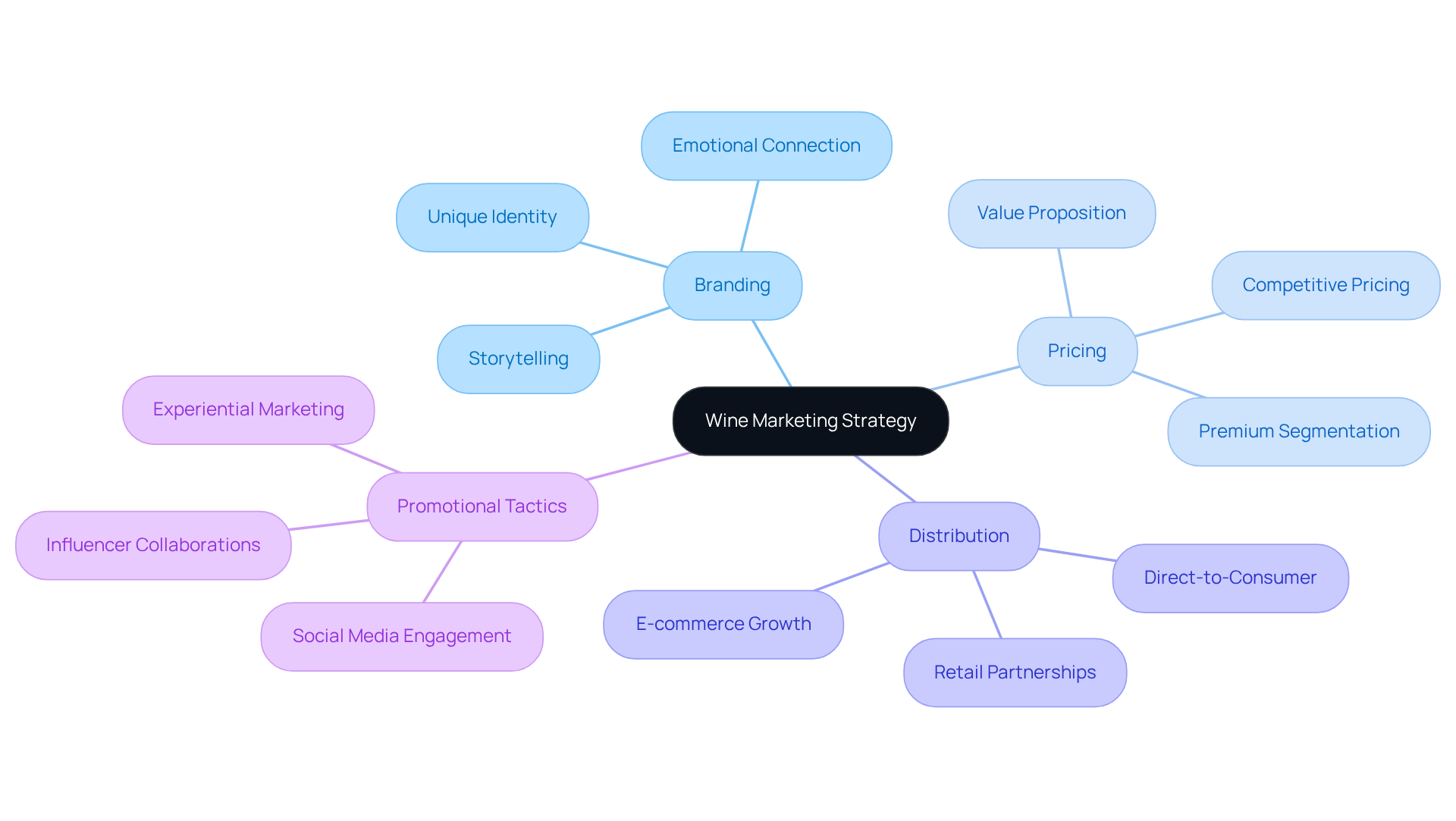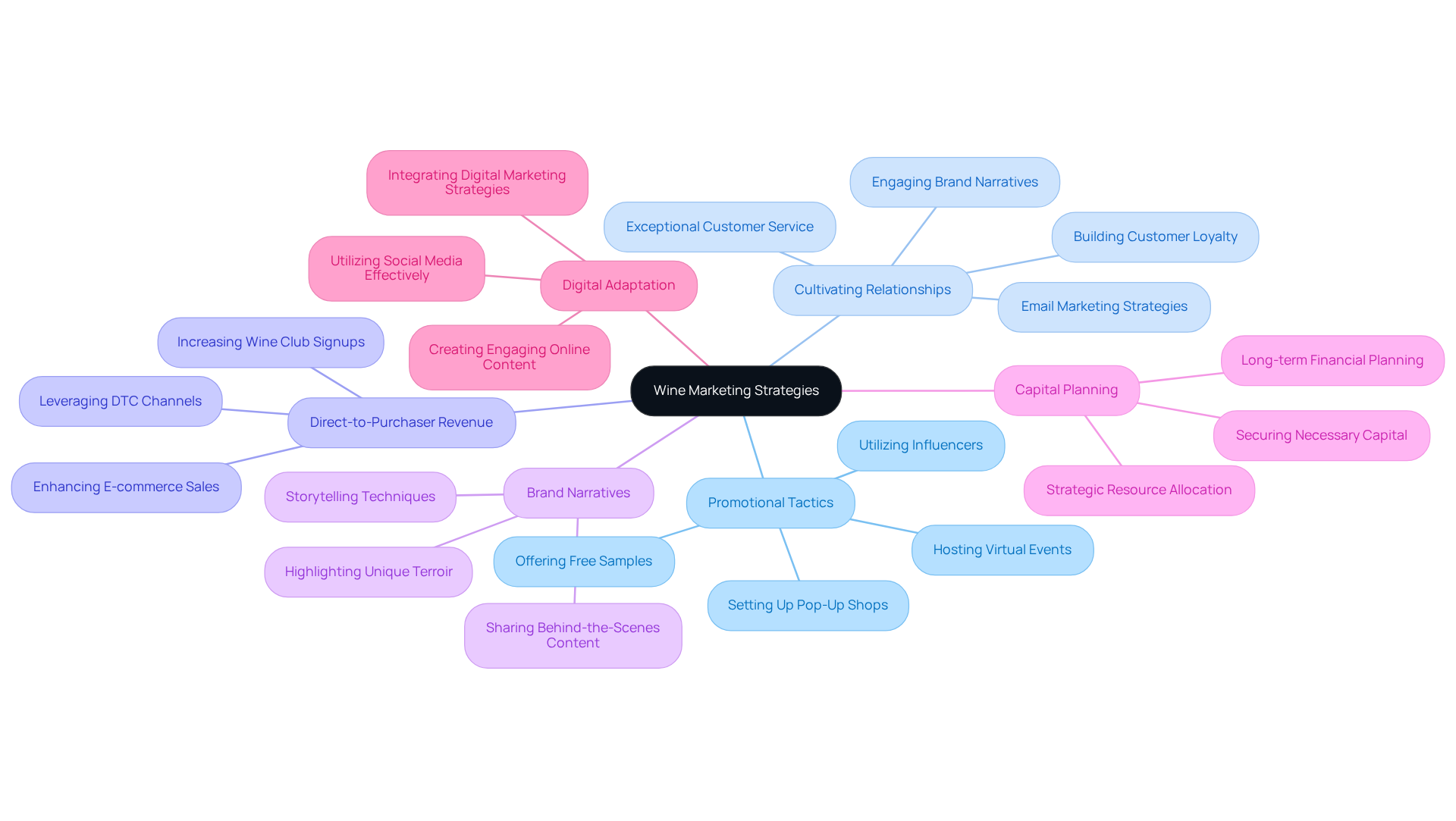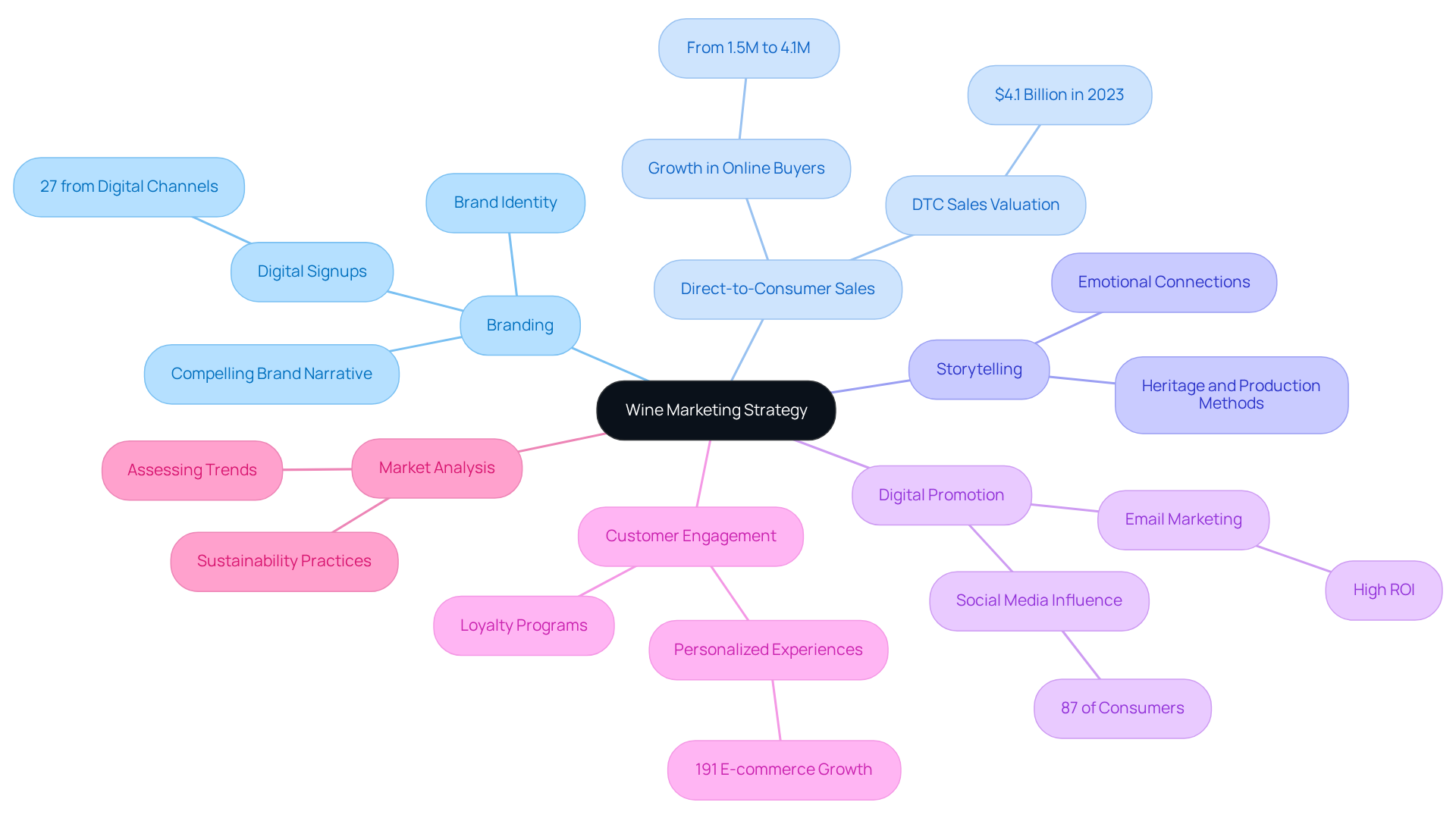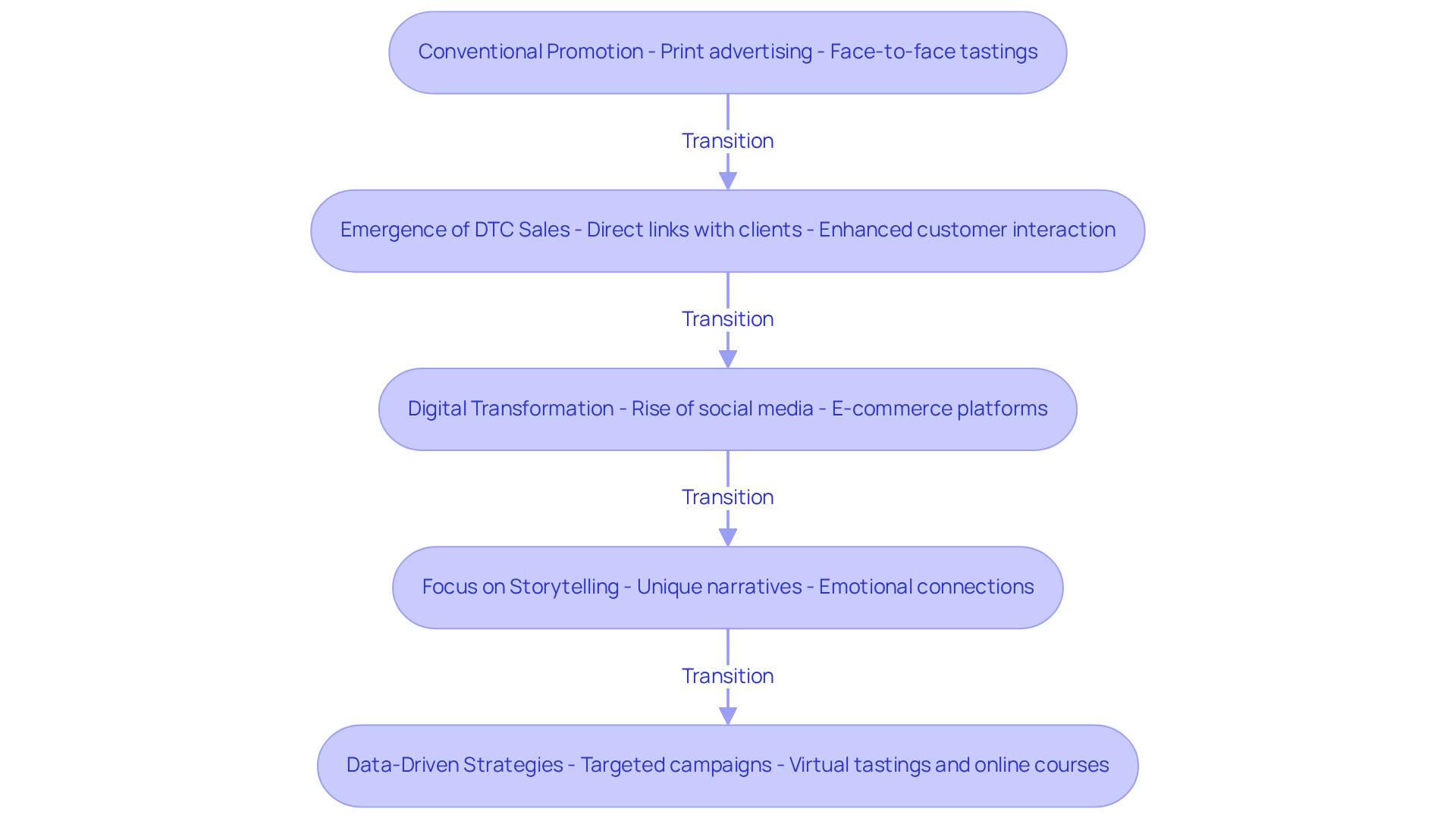Overview
This article examines the essential components and evolution of wine marketing strategies, underscoring the critical roles of:
- Branding
- Direct-to-consumer sales
- Storytelling
- Digital promotion
It reveals how these elements have transformed over time, particularly in response to the surge of online commerce and the imperative for emotional connections with consumers. Such connections are vital for driving sales and cultivating brand loyalty in an increasingly competitive market.
Introduction
The realm of wine is as rich and diverse as the beverages themselves; however, many wineries grapple with establishing a distinct identity in an increasingly competitive market. A meticulously crafted wine marketing strategy is not merely a luxury; it is an essential component for success, providing a roadmap for engaging consumers and driving sales.
As the industry continues to evolve, how can vineyards effectively leverage storytelling, digital promotion, and direct-to-consumer channels to transform casual buyers into loyal patrons?
This article delves into the critical components of a successful wine marketing strategy and examines the dynamic shifts that have shaped the industry, offering insights poised to redefine the future of wine marketing.
Define Wine Marketing Strategy
A wine promotion approach represents a comprehensive strategy outlining how a winery will effectively advertise its products, engage with buyers, and ultimately drive sales. This strategy encompasses critical elements such as branding, pricing, distribution, and promotional tactics specifically designed for the wine market. Unlike generic marketing strategies, a must consider the unique characteristics of wine buyers, who usually prioritize quality, storytelling, and direct engagement with producers.
Effective branding is paramount in this context, as it allows vineyards to create a unique identity that resonates with buyers' values and aspirations. By developing compelling narratives around their offerings, wine producers can forge emotional connections that enhance consumer loyalty and differentiate themselves within a competitive landscape. For instance, establishments that share authentic narratives about their grape-growing processes and production methodologies can foster deeper connections with customers, ultimately leading to increased sales and heightened brand recognition.
Enocap underscores the significance of converting casual buyers into loyal club members through proven direct-to-consumer strategies, which have resulted in an impressive average e-commerce growth of 191% for clients in 2020. Additionally, Enocap offers services such as media placement, public relations, and strategic capital planning to further support vineyards in their promotional endeavors.
As the sector evolves, implementing a wine marketing strategy that includes contemporary promotional techniques—such as tailored experiences and online interactions—becomes increasingly vital for vineyards striving for success in today's marketplace.

Contextualize the Importance of Wine Marketing Strategies
In today's competitive environment, a strong wine marketing strategy that focuses on promotional tactics is paramount, as buyers increasingly seek direct connections with brands. For family-operated vineyards, effective marketing transcends mere sales; it is about cultivating relationships and fostering loyalty. Enocap highlights the importance of unlocking direct-to-purchaser revenue and crafting engaging brand narratives that resonate with buyers. Moreover, strategic capital planning is essential for sustainable growth, enabling businesses to secure the necessary resources for their operations.
With the rise of online commerce and , vineyards must adapt their wine marketing strategy to directly connect with customers, enhancing their narratives and brand visibility. This adaptation is particularly crucial as the wine industry grapples with challenges such as cash flow issues and the necessity for meaningful consumer connections. By implementing proven methods to transform casual purchasers into dedicated club members, alongside efficient capital planning, a well-designed wine marketing strategy can aid vineyards in navigating these challenges, ensuring they remain relevant and competitive.

Identify Key Components of a Wine Marketing Strategy
Key components of a successful wine marketing strategy encompass several essential elements:
- Branding: A robust brand identity that resonates with customers and embodies the winery's values and narrative is paramount. Effective branding significantly enhances recognition and loyalty, particularly as 27% of new wine club signups now stem from digital channels. Enocap underscores the necessity of crafting a compelling brand narrative within its wine marketing strategy that not only attracts customers but also cultivates long-term loyalty.
- Direct-to-Consumer (DTC) Sales: Establishing strong DTC channels, including e-commerce platforms and wine clubs, is vital for direct customer engagement. In 2023, DTC sales reached a valuation of $4.1 billion, representing approximately 5% of total U.S. wine sales, highlighting the significance of this revenue stream. Enocap's wine marketing strategy has led to remarkable outcomes, as the number of online wine buyers increased from 1.5 million to 4.1 million during their engagement, showcasing the expanding market potential.
- Storytelling: Developing captivating narratives surrounding the establishment's heritage, production methods, and unique offerings fosters emotional connections with consumers. Enocap advocates for a storytelling approach as part of their wine marketing strategy that enhances brand loyalty and distinguishes vineyards in a competitive landscape, making their offerings more relatable and memorable.
- Digital Promotion: Effectively utilizing social media, email outreach, and content strategies is crucial for reaching and engaging target audiences. For instance, establishments leveraging social media marketing can bolster brand recognition, as 87% of consumers believe social media influences their purchasing decisions. Enocap's expertise in digital marketing can aid vineyards in enhancing their wine marketing strategy as well as their online visibility and engagement.
- Customer Engagement: Implementing loyalty programs and personalized experiences nurtures long-term customer relationships. Involving customers through tailored experiences can significantly improve retention rates, as evidenced by the 191% average e-commerce growth observed by Enocap clients in 2020, driven by strategies such as optimizing wine club memberships and demand generation methods.
- Market Analysis and Strategic Capital Planning: Continuously assessing market trends and customer preferences enables wineries to adapt their strategies accordingly. This proactive approach is essential, particularly as in the U.S. reaches unprecedented levels, necessitating innovative promotional tactics. Furthermore, integrating sustainability practices into promotional efforts aligns with consumer preferences, especially among younger demographics who prioritize eco-friendly initiatives. Enocap also emphasizes strategic capital planning for debt, equity, or acquisition opportunities, ensuring that wineries are well-prepared to navigate financial challenges.
These elements collectively form a cohesive wine marketing strategy that enhances sales and fosters enduring brand loyalty, particularly when supported by Enocap's transformative DTC methods and capital advisory.

Trace the Evolution of Wine Marketing Strategies
The evolution of wine marketing strategies can be traced through several key phases:
- Conventional Promotion: Initially, vineyards relied heavily on conventional promotional techniques, such as print advertising and face-to-face tastings, to market their products and engage with buyers.
- Emergence of DTC Sales: The late 1990s and early 2000s marked a pivotal shift as wineries began to explore direct-to-consumer (DTC) sales channels. This wine marketing strategy enabled them to forge direct links with clients, which enhanced customer interaction and loyalty—essential components for maintaining cash flow.
- Digital Transformation: The 2010s ushered in a revolution in wine marketing with the rise of social media and e-commerce platforms. Wineries could now engage wider audiences and involve consumers through innovative online strategies, fundamentally changing their wine marketing strategy and the way wine is promoted and sold. Enocap's expertise in wine marketing strategy aids wineries in effectively navigating this digital landscape.
- Focus on Storytelling: Recently, there has been a marked shift towards storytelling as a crucial marketing tool. Wineries increasingly emphasize their in their wine marketing strategy to stand out in a crowded market, fostering deeper emotional connections with consumers. Enocap assists vineyards in crafting engaging narratives that resonate with their target audience, which is a crucial aspect of their wine marketing strategy, transforming casual purchasers into loyal club members.
- Today, wineries are leveraging data analytics to inform their wine marketing strategy. This data-driven approach facilitates more targeted and efficient campaigns, aligning marketing initiatives with evolving customer preferences and behaviors. The pandemic has further accelerated the adoption of virtual tastings and online wine courses, illustrating a significant shift in consumer behavior towards digital experiences. Understanding these changes is crucial for wineries aiming to remain relevant in the market, and Enocap's market intelligence services provide the insights necessary for developing a wine marketing strategy that includes capital planning for sustainable growth.

Conclusion
The significance of a well-crafted wine marketing strategy cannot be overstated; it serves as the backbone for wineries aiming to connect authentically with their consumers. This strategic approach encompasses not only branding, pricing, and distribution but also emphasizes the critical importance of storytelling and direct engagement. By understanding and adapting to the unique preferences of wine buyers, vineyards can foster loyalty and drive sustainable growth in a competitive marketplace.
Key components such as direct-to-consumer sales, effective branding, and digital promotion play a crucial role in shaping successful wine marketing strategies. Enocap's insights demonstrate that the shift towards online interactions and personalized experiences has proven instrumental in converting casual purchasers into dedicated customers. Furthermore, the evolution of these strategies—from traditional methods to data-driven approaches—highlights the necessity for wineries to remain agile and responsive to changing consumer behaviors.
In light of these insights, it is essential for wineries to embrace innovative marketing tactics that resonate with their target audiences. As the landscape of wine marketing continues to evolve, leveraging digital platforms and crafting compelling narratives will be vital for success. Wineries are encouraged to prioritize these strategies not just for immediate sales, but for building lasting relationships that ensure their relevance and competitiveness in the future.
Frequently Asked Questions
What is a wine marketing strategy?
A wine marketing strategy is a comprehensive plan that outlines how a winery will advertise its products, engage with buyers, and drive sales. It includes elements such as branding, pricing, distribution, and promotional tactics specifically tailored for the wine market.
Why is effective branding important in wine marketing?
Effective branding is crucial as it helps vineyards create a unique identity that resonates with buyers' values and aspirations. It allows producers to develop compelling narratives around their offerings, fostering emotional connections with consumers and enhancing loyalty.
How can storytelling impact wine sales?
Storytelling can impact wine sales by allowing producers to share authentic narratives about their grape-growing processes and production methodologies. This fosters deeper connections with customers, leading to increased sales and heightened brand recognition.
What are some strategies to convert casual buyers into loyal customers?
Strategies to convert casual buyers into loyal customers include implementing direct-to-consumer approaches, such as wine clubs, which have shown significant e-commerce growth for clients.
What services does Enocap provide to support wineries?
Enocap provides services such as media placement, public relations, and strategic capital planning to support vineyards in their promotional efforts.
What contemporary promotional techniques should wineries consider?
Wineries should consider contemporary promotional techniques such as tailored experiences and online interactions to succeed in today's marketplace.




